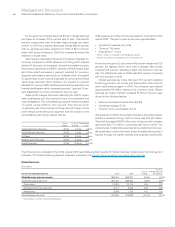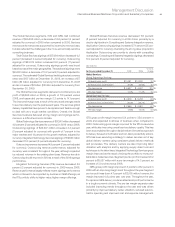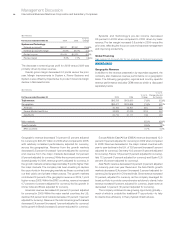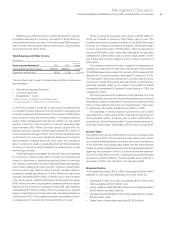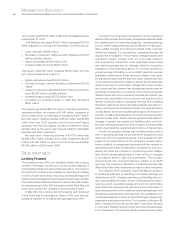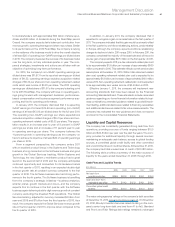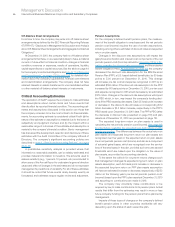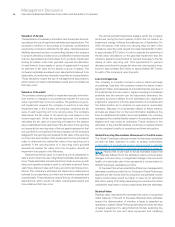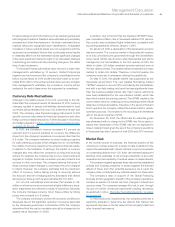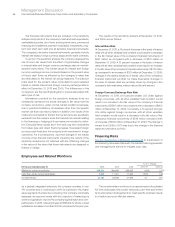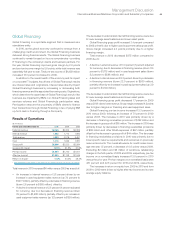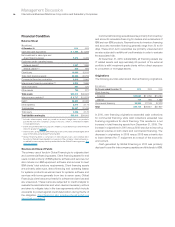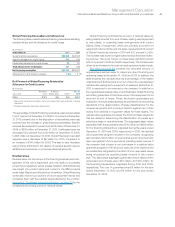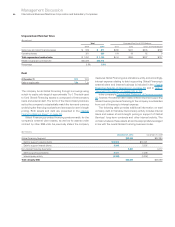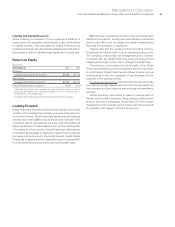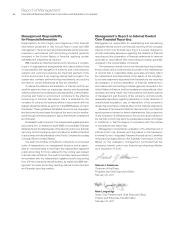IBM 2010 Annual Report Download - page 52
Download and view the complete annual report
Please find page 52 of the 2010 IBM annual report below. You can navigate through the pages in the report by either clicking on the pages listed below, or by using the keyword search tool below to find specific information within the annual report.
50
Management Discussion
International Business Machines Corporation and Subsidiary Companies
Off-Balance Sheet Arrangements
From time to time, the company may enter into off-balance sheet
arrangements as defined by the SEC Financial Reporting Release
67 (FRR-67), “Disclosure in Management’s Discussion and Analysis
about Off-Balance Sheet Arrangements and Aggregate Con tractual
Obligations.”
At December 31, 2010, the company had no off-balance sheet
arrangements that have, or are reasonably likely to have, a material
current or future effect on financial condition, changes in financial
condition, revenues or expenses, results of operations, liquidity,
capital expenditures or capital resources. See the table on page 49
for the company’s contractual obligations and note O, “Contingencies
and Commitments,” on pages 103 through 105, for detailed infor-
mation about the company’s guarantees, financial commitments
and indemnification arrangements. The company does not have
retained interests in assets transferred to unconsolidated entities
or other material off-balance sheet interests or instruments.
Critical Accounting Estimates
The application of GAAP requires the company to make estimates
and assumptions about certain items and future events that
directly affect its reported financial condition. The accounting esti-
mates and assumptions discussed in this section are those that
the company considers to be the most critical to its financial state-
ments. An accounting estimate is considered critical if both (a) the
nature of the estimate or assumption is material due to the levels of
subjectivity and judgment involved, and (b) the impact within a
reasonable range of outcomes of the estimate and assumption is
material to the company’s financial condition. Senior management
has discussed the development, selection and disclosure of these
estimates with the Audit Committee of the company’s Board of
Directors. The company’s significant accounting policies are
described in note A, “Significant Accounting Policies,” on pages
68 to 79.
A quantitative sensitivity analysis is provided where that
information is reasonably available, can be reliably estimated and
provides material information to investors. The amounts used to
assess sensitivity (e.g., 1 percent, 10 percent, etc.) are included to
allow users of the Annual Report to understand a general direction
cause and effect of changes in the estimates and do not represent
management’s predictions of variability. For all of these estimates,
it should be noted that future events rarely develop exactly as
forecasted, and estimates require regular review and adjustment.
Pension Assumptions
For the company’s defined benefit pension plans, the measure-
ment of the benefit obligation to employees and the net periodic
pension cost/(income) requires the use of certain assumptions,
including, among others, estimates of discount rates and expected
return on plan assets.
Changes in the discount rate assumptions will impact the
(gain)/loss amortization and interest cost components of the net
periodic pension cost/(income) calculation (see page 118 for infor-
mation regarding the discount rate assumptions) and the projected
benefit obligation (PBO). As presented on page 118, the company
decreased the discount rate assumption for the IBM Personal
Pension Plan (PPP), a U.S.-based defined benefit plan, by 60 basis
points to 5.00 percent on December 31, 2010. This change
will increase pre-tax cost and expense recognized in 2011 by an
estimated $166 million. If the discount rate assumption for the PPP
increased by 60 basis points on December 31, 2010, pre-tax cost
and expense recognized in 2011 would decrease by an estimated
$173 million. Changes in the discount rate assumptions will impact
the PBO which, in turn, may impact the company’s funding deci-
sions if the PBO exceeds plan assets. Each 25 basis point increase
or decrease in the discount rate will cause a corresponding $1.2
billion decrease or $1.3 billion increase, respectively, in the PPP’s
PBO based upon December 31, 2010 data. The PPP’s PBO (after
the decrease in discount rate presented on page 118) and plan
assets as of December 31, 2010 are presented on page 116.
The expected long-term return on plan assets is used in
calculating the net periodic pension cost/(income). See page 118
for information regarding the expected long-term return on plan
assets assumption. The differences between the actual return on
plan assets and expected long-term return on plan assets are
recognized over five years in the expected return on plan assets
line in net periodic pension cost/(income) and also as a component
of actuarial gains/losses, which are recognized over the service
lives of the employees in the plan, provided such amounts exceed
thresholds which are based upon the obligation or the value of
plan assets, as provided by accounting standards.
To the extent the outlook for long-term returns changes such
that management changes its expected long-term return on plan
assets assumption, each 50 basis point increase or decrease in
the expected long-term return on PPP plan assets assumption
will have an estimated increase or decrease, respectively, of $253
million on the following year’s pre-tax net periodic pension cost/
(income) (based upon the PPP’s plan assets at December 31, 2010
and assuming no contributions are made in 2011).
The company may voluntarily make contributions or be
required, by law, to make contributions to its pension plans. Actual
results that differ from the estimates may result in more or less
future company funding into the pension plans than is planned by
management.
Impacts of these types of changes on the company’s defined
benefit pension plans in other countries worldwide will vary
depending upon the status of each respective plan.


